Fading Sunset |
|
 |
 |
Knitted jumper in 2 strands DROPS Alpaca or 1 thread Nepal. The piece is worked top down with raglan and stripe. Sizes S - XXXL. Knitted hat in 2 strands DROPS Alpaca. The piece is worked with turn-up, stripes and pom pom. Knitted scarf in 2 strands DROPS Alpaca. The piece is worked with garter stitch and stripes.
DROPS 197-7 |
|
|
------------------------------------------------------- EXPLANATIONS FOR THE PATTERN: ------------------------------------------------------- RIDGE/GARTER STITCH (worked back and forth): 1 ridge = Knit 2 rows. INCREASE TIP (evenly spaced): To work out how to increase evenly, count the total number of stitches on the needle (e.g. 78 stitches) and divide by the number of increases to be made (e.g. 26) = 3. In this example, increase by making 1 yarn over after every 3rd stitch. On the next round, knit the yarn overs twisted to avoid holes. RAGLAN: Increase to raglan on each side of the 4 marker threads as follows: Start 1 stitch before the stitch with the marker thread, make 1 yarn over, knit 3 (the marker thread sits in the middle stitch of the 3), make 1 yarn over (= 2 stitches increased). On the next round knit the yarn overs twisted to avoid holes. The new stitches are then worked in stocking stitch. DECREASE TIP-1 (for sleeves): Decrease 1 stitch on each side of the marker thread as follows: Work until there are 3 stitches left before the marker thread, knit 2 together, knit 2 (the marker thread sits between these 2 stitches), slip 1 stitch as if to knit, knit 1, pass the slipped stitch over the knitted stitch (= 2 stitches decreased). DECREASE TIP-2 (for top of hat): Start after the marker thread and work as follows: Slip 1 stitch as if to knit, knit 1, pass the slipped stitch over the knitted stitch (= 1 stitch decreased). STRIPES YOKE: The stripes are given in cm, but if the knitting tension is correct in height you can work twice as many rounds as given in cm (2 cm = 4 rounds, 3 cm = 6 rounds etc). All stripes are worked in stocking stitch with 2 strands Alpaca or 1 stransd Nepal: 2-3-3-3-4-4 cm with off white and light camel Alpaca / beige Nepal 2-2-2-2-2-3 cm with off white and olive Alpaca / light olive Nepal 1-1-2-2-2-2 cm with off white and denim/green Alpaca / grey green Nepal 5-5-6-6-6-7 cm with denim/green and light camel Alpaca / grey green Nepal 2-2-2-3-3-3 cm with off white and rust Alpaca / orange Nepal 3-4-4-4-5-5 cm with off white and light pearl grey Alpaca / light grey Nepal 1-1-1-1-1-1 cm with light pearl grey and light brown Alpaca / medium brown Nepal 2-2-2-3-3-3 cm with light pearl grey and light camel Alpaca / beige Nepal STRIPES BODY: The given cm measurements are for all sizes and the stripes continue in stocking stitch with 2 strands Alpaca or 1 strand Nepal: 4 cm with light pearl grey and light maroon Alpaca / deep red Nepal 2 cm with light pearl grey and off white Alpaca / light grey Nepal 3 cm with light pearl grey and olive Alpaca / light olive Nepal 6 cm with light pearl grey and aqua grey Alpaca / light grey green Nepal 2 cm with light pearl grey and off white Alpaca / light grey Nepal 1 cm with light pearl grey and light maroon Alpaca / deep red Nepal 5 cm with light pearl grey and rust Alpaca / orange Nepal 2 cm with light pearl grey and light camel Alpaca / beige Nepal 1 cm with light pearl grey and light brown Alpaca / medium brown Nepal STRIPES SLEEVES: The stripes continue in stocking stitch with 2 strands Alpaca or 1 strand Nepal: 7-7-7-6-6-5 cm with light pearl grey and off white Alpaca / light grey Nepal 1-1-1-1-1-1 cm with light pearl grey and olive Alpaca / light olive Nepal 4-4-4-4-3-3 cm with light pearl grey and aqua grey Alpaca / light grey green Nepal 7-7-7-6-6-5 cm with light pearl grey and off white Alpaca / light grey Nepal 1-1-1-1-1-1 cm with light pearl grey and light maroon Alpaca / deep red Nepal 4-4-4-4-3-3 cm with light pearl grey and rust Alpaca / orange Nepal 7-7-7-6-6-5 cm with light pearl grey and off white Alpaca / light grey Nepal 1-1-1-1-1-1 cm with off white and olive Alpaca / light olive Nepal 4-4-4-4-3-3 cm with off white and denim/green Alpaca / grey green Nepal Then work with light pearl grey and off white (= 2 strands Alpaca) or 1 strand light grey to finished length. STRIPES HAT: The stripes are given in cm and are for both sizes. If the knitting tension is correct in height, you can work double so many rounds as given in cm (2 cm = 4 rounds, 3 cm = 6 rounds etc). All stripes are worked in stocking stitch with 2 strands Alpaca: 3 cm with light pearl grey and olive 5 cm with light pearl grey and aqua grey 2 cm with light pearl grey and off white 1 cm with light pearl grey and light maroon 4 cm with light pearl grey and rust 2 cm with light pearl grey and light camel 1 cm with light pearl grey and light brown Continue with light pearl grey and off white (= 2 strands) to finished length. STRIPES SCARF: Stripes are given in cm. All stripes are worked in garter stitch with 2 strands Alpaca as follows: 2 cm with off white and light camel 2 cm with off white and olive 1 cm with off white and denim/green 5 cm with denim/green and light camel 2 cm with off white and rust 3 cm with off white and light pearl grey 1 cm with light pearl grey and light brown 2 cm with light pearl grey and light camel 4 cm with light pearl grey and light maroon 2 cm with light pearl grey and off white 3 cm with light pearl grey and olive 6 cm with light pearl grey and aqua grey 2 cm with light pearl grey and off white 1 cm with light pearl grey and light maroon 5 cm with light pearl grey and rust 2 cm with light pearl grey and light camel 1 cm with light pearl grey and light brown 4 cm with light pearl grey and off white. Repeat the stripes to finished length. ------------------------------------------------------- START THE PIECE HERE: ------------------------------------------------------- JUMPER – SHORT OVERVIEW OF THE WORK: The yoke and body are worked in the round with circular needle, top down. The sleeves are worked in the round with circular needle/double pointed needles, top down. The whole piece is worked with 2 strands Alpaca or 1 strand i Nepal. NECK: Cast on 78-84-84-90-96-102 stitches with short circular needle size 4.5 mm and 1 strand light pearl grey and 1 strand light brown (= 2 strands Alpaca) or 1 strand medium brown Nepal. Knit 1 round. Then work the next round as follows: Knit 2, * purl 3, knit 3 *, work from *-* until there are 4 stitches left on the round, purl 3 and finish with knit 1. Change to 1 strand light pearl grey + 1 strand light camel (= 2 strands Alpaca) or 1 strand beige Nepal and continue the rib. When the neck measures 3 cm knit 1 round where you increase 26-28-28-30-32-34 stitches evenly on round – read INCREASE TIP = 104-112-112-120-128-136 stitches. Change to circular needle size 5.5 mm. Continue by working yoke as described below. YOKE: Insert 4 marker threads for raglan in the piece as follows (without working the stitches): Count 18-20-20-22-24-26 stitches (= ½ back piece), insert 1 marker thread in the next stitch, count 14 stitches (= sleeve), insert 1 marker thread in the next stitch, count 36-40-40-44-48-52 stitches (= front piece), insert 1 marker thread in the next stitch, count 14 stitches (= sleeve), insert 1 marker thread in the next stitch. There are 18-20-20-22-24-26 stitches left on the round after the last marker thread (= ½ back piece). Work STRIPES YOKE – read description above. REMEMBER THE KNITTING TENSION! AT THE SAME TIME on the first round begin to increase to RAGLAN – read description above (= 8 stitches increased). Continue to increase to raglan every 2nd round until you have increased a total of 16-18-20-22-24-26 times on each side of the 4 marker threads = 232-256-272-296-320-344 stitches on the needle. Finish working STRIPES YOKE. The piece now measures approx. 21-23-25-27-29-31 cm from the cast-on edge mid front. On the next round divide the stitches for body and sleeves as follows (continue with the colours in the last stripe): Knit 35-38-41-45-49-53 stitches (= ½ back piece), place the next 46-52-54-58-62-66 stitches on 1 thread for sleeve, cast on 6-6-8-8-10-10 new stitches on the needle (= in side under the sleeve), knit 70-76-82-90-98-106 stitches (= front piece), place the next 46-52-54-58-62-66 stitches on 1 thread for sleeve, cast on 6-6-8-8-10-10 new stitches on needle (= in side under the sleeve) and knit the remaining 35-38-41-45-49-53 stitches (= ½ back piece). Cut the strands. Body and sleeves are finished separately. THE PIECE S NOW MEASURED FROM HERE! BODY: = 152-164-180-196-216-232 stitches. Start the round in the middle of the 6-6-8-8-10-10 stitches cast on under the one sleeve. Continue in the round with stocking stitch and STRIPES BODY – read description above. When the piece measures 26 cm from the division (the stripes should now be finished), knit 1 round with the colours in the last stripe and increase 22-28-30-32-36-38 stitches evenly on round = 174-192-210-228-252-270 stitches. Change to circular needle size 4.5 mm and work rib with 1 strand light pearl grey and + 1 strand off white (= 2 strands Alpaca) or 1 strand light grey Nepal as follows: Knit 2, * purl 3, knit 3 *, work from *-* until there are 4 stitches left on the row, purl 3 and finish with knit 1. Continue the rib like this for 6 cm. Then loosely cast off with knit over knit and purl over purl; make sure the cast-off edge is not tight (if it is tight, cast off with a larger needle size). The jumper measures approx. 56-58-60-62-64-66 cm from the shoulder down. SLEEVE: Place the 46-52-54-58-62-66 stitches from the thread on one side of the piece on short circular needle size 5.5 mm and in addition knit up 1 stitch in each of the 6-6-8-8-10-10 stitches cast on under the sleeve = 52-58-62-66-72-76 stitches on the needle. Insert 1 marker thread in the middle of the 6-6-8-8-10-10 stitches (= mid under sleeve). Allow the marker thread to follow your work onwards, it will be used when decreasing mid under sleeve. Work STRIPES SLEEVE – read description above. AT THE SAME TIME when the piece measures 2-2-3-2-3-3 cm from the division, decrease 2 stitches mid under sleeve - read DECREASE TIP-1. Decrease like this every 4½-3½-3-3-2-2 cm a total of 9-11-11-12-14-14 times = 34-36-40-42-44-48 stitches. Continue working until the piece measures approx. 40-39-37-36-34-32 cm from the division (the decreases should now be finished). Continue with 1 strand light pearl grey + 1 strand off white (= 2 strands Alpaca) or 1 strand light grey Nepal. Knit 1 round where you increase 2-6-8-6-4-6 stitches evenly on round = 36-42-48-48-48-54 stitches. Change to double pointed needles size 4.5 mm and work rib in the round (= knit 3 / purl 3) for 4 cm. Then loosely cast off with knit over knit and purl over purl; make sure the cast-off edge is not tight (if it is tight, cast off with a larger needle size). The sleeve measures approx. 44-43-41-40-38-36 cm from the division. Work the other sleeve in the same way. ------------------------------------------------------- HAT – SHORT OVERVIEW OF THE WORK: The piece is worked in the round with circular needle, bottom up. Change to double pointed needles when necessary. First work rib which is folded up to finish. Then work stripes in stocking stitch. A pom pom is attached to the top. HAT: Cast on 90-96 stitches with short circular needle size 3.5 mm and 1 strand off white and 1 strand light pearl grey (= 2 strands). Work rib in the round (= knit 3 / purl 3) for 10-10 cm. Knit 1 round where you decrease 6 stitches evenly on round (in S/M knit together every 14th and 15th stitch and in M/L knit together every 15th and 16th stitch) = 84-90 stitches. Change to circular needle size 4.5 mm and work stocking stitch and STRIPES HAT – read description above. REMEMBER THE KNITTING TENSION! When the piece measures 25-26 cm from the cast-on edge, insert 6 marker threads (the marker threads will be used when decreasing and are inserted without working the stitches): The first marker thread is inserted at the beginning of the round, then the next 5 marker threads with 14-15 stitches between each one. On the next round decrease 1 stitch after each marker thread – read DECREASE TIP-2 = 6 stitches decreased. Decrease like this every 2nd round a total of 5 times and then every round a total of 4 times in both sizes = 30-36 stitches left on the needles. Work 2 rounds where all stitches are knitted together 2 and 2 on both rounds = 8-9 stitches left on the needles. Cut the strand, pull it through the remaining stitches, tighten and fasten well. The hat measures approx. 31-32 cm from the top down. Fold up the bottom 5 cm of rib. POM POM: Make a pom pom of approx. 4 cm in diameter, with all the colours. Sew the pom pom to the top of the hat. ------------------------------------------------------- SCARF – SHORT OVERVIEW OF THE WORK: The piece is worked back and forth on the needle. The whole scarf is worked in garter stitch and stripes. SCARF: Cast on 48 stitches with needle size 5.5 mm and 1 strand off white and 1 strand light pearl grey (= 2 strands). Work GARTER STITCH – read description above. REMEMBER THE KNITTING TENSION! When the piece measures 12 cm work STRIPES SCARF. The stripes are repeated until the piece measures approx. 156 cm, or to desired length. Change to 1 strand off white and 1 strand light pearl grey. Work garter stitch for 4 cm. Then loosely cast off with knit from the right side. The scarf measures approx. 160 cm. |
|
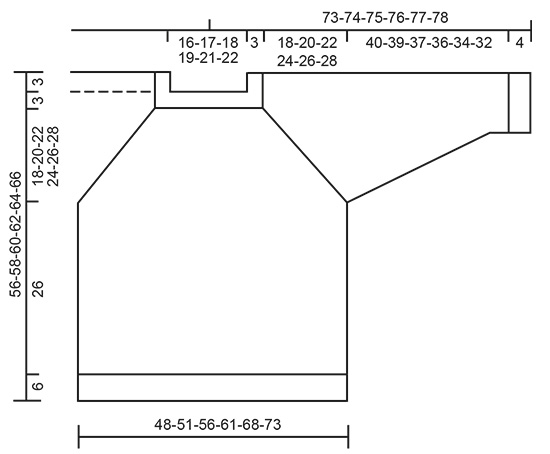
|
|
|
Have you made this or any other of our designs? Tag your pictures in social media with #dropsdesign so we can see them! Do you need help with this pattern?You'll find tutorial videos, a Comments/Questions area and more by visiting the pattern on garnstudio.com. © 1982-2024 DROPS Design A/S. We reserve all rights. This document, including all its sub-sections, has copyrights. Read more about what you can do with our patterns at the bottom of each pattern on our site. |
|







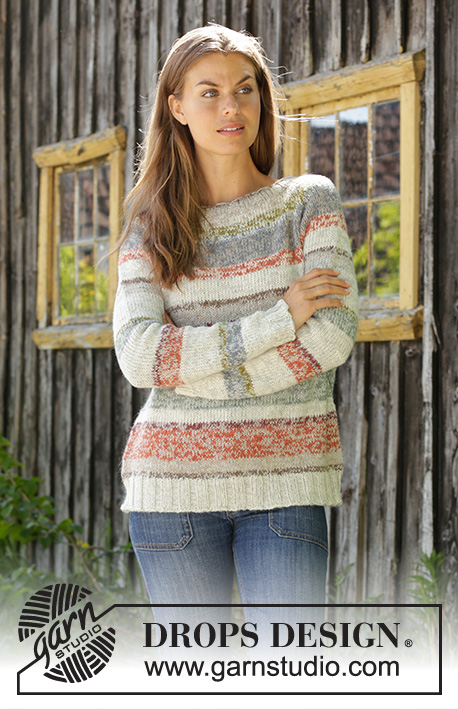
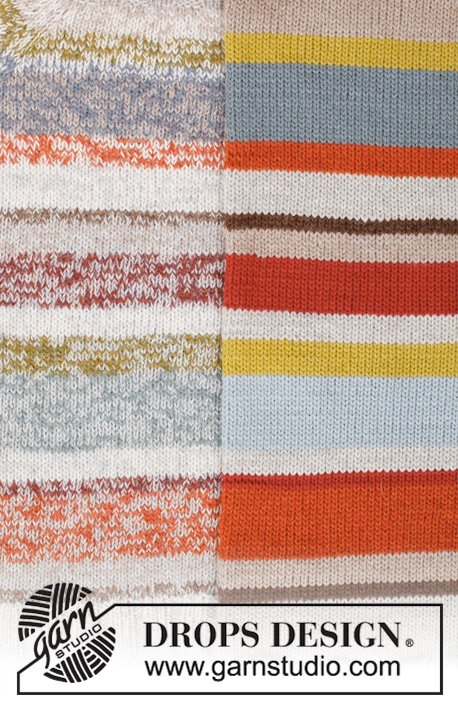










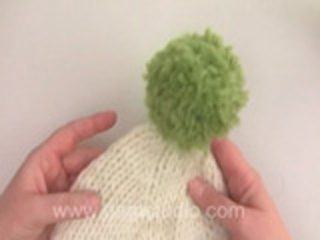








































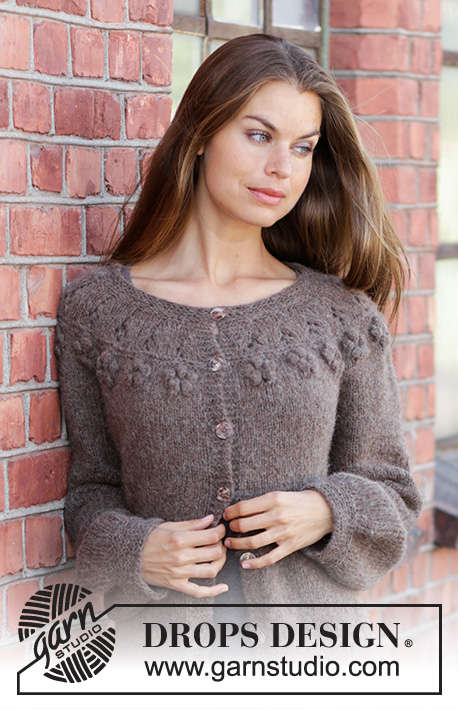







Comments / Questions (16)
Ik kan haast niet wachten tot het patroon beschikbaar komt. Heel mooi! Simpel maar elegant.
25.07.2018 - 17:28Schitterende kleuren. Deze zou ik absoluut willen breien!
15.07.2018 - 11:50Bela combinação de cores! Gosto muito!
12.06.2018 - 15:35Love it!
08.06.2018 - 11:25I love the colours chosen to knit this pattern. I would name it "Strips & Stripes" or even "Candy Canes" My Grand Daughter would love it when she goes skiing. Thank you.
06.06.2018 - 21:57Un modèle superbe et un choix des coloris de très bon goût. L'ensemble est très classe. Félicitations.
05.06.2018 - 15:26